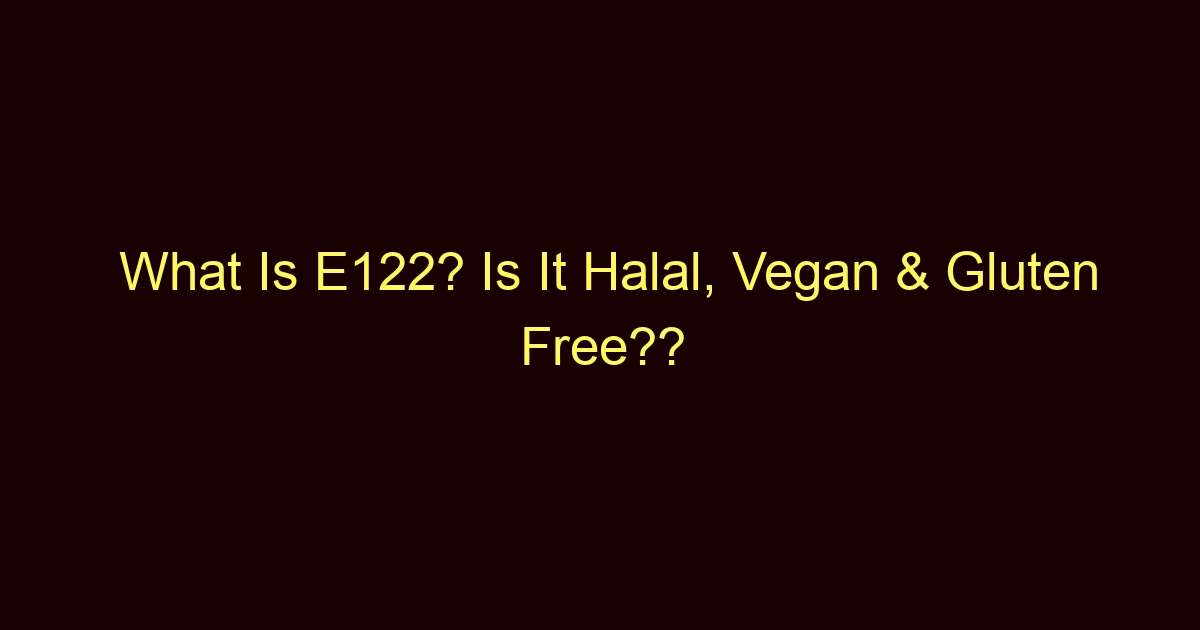We’re back at it, diving deep into another intriguing food additive. This time, it’s the turn of E122, a colorant that has caught the attention of many health-conscious consumers. Given the escalating importance of special diets like Halal, Vegan, and Gluten-free, understanding such additives is critical. Let’s unravel the mystery surrounding E122.
What is E122?
E122, better known as Carmoisine or Azorubine, is a synthetic red dye used predominantly in the food and cosmetics industries. If you’ve ever marveled at the vibrancy of some candies, sodas, or even cosmetics, there’s a good chance E122 played a role. This additive grants products a captivating pinkish-red hue, making them more aesthetically appealing to the consumer.
Its journey from a laboratory concoction to the shelves of supermarkets is indeed fascinating. But it’s worth noting that E122, like most food colorants, has been surrounded by debates. While some view it as a harmless enhancer of visual appeal, others raise eyebrows over potential side effects. It’s also worth mentioning that this particular dye has been linked to allergic reactions in some sensitive individuals and has been a topic of discussion regarding its effects on children’s behavior.
How is E122 Made?
E122 is a synthetic compound derived from coal tar or azo dye. Sounds industrial, right? The process involves the synthesis of aromatic compounds. Azo dyes are a group of dyes that contain an azo group (-N=N-) as part of their molecular structure. This might sound complex, but in layman’s terms, it’s a compound born from the amalgamation of organic components in specific conditions.
It’s essential to highlight that the production and usage of E122 adhere to rigorous standards, especially when it comes to food applications. Regulatory authorities across the globe ensure its safety and determine permissible limits. However, its usage varies by country. Some countries have banned or limited its use due to potential health concerns.
Is E122 Halal?
Yes, from a purely compositional standpoint, E122 is considered Halal. It’s a synthetic compound and isn’t directly derived from animal sources, alcohol, insects, or wine.
However, the waters get murky when you dive into the production processes or the potential cross-contamination in factories. Therefore, it’s imperative for those strictly adhering to Halal dietary practices to opt for products where the E122 is certified Halal to avoid any potential conflicts.
Is E122 Vegan?
Yes, E122 or Carmoisine is generally considered Vegan. Given its synthetic origin and lack of animal-derived ingredients in its production, it’s typically safe for vegans. However, it’s always a good practice for vegans to double-check specific brands or products, ensuring no animal testing was involved or other non-vegan processes.
Is E122 Gluten Free?
Yes, E122 is gluten-free. As a chemical compound, it doesn’t contain wheat, barley, rye, or any other gluten-contributing grains. So, for those with celiac disease or those choosing a gluten-free lifestyle, E122 doesn’t pose any direct gluten-related threats. But, a word of caution: always inspect the complete ingredient list for potential gluten sources.
E122: Is It Safe or Harmful?
E122’s safety profile is contentious. While it’s approved for use within specific limits by some regulatory agencies, concerns have arisen about its consumption, especially in children. Some studies have hinted at a potential link between E122 and hyperactivity in children, which led certain countries to either ban or restrict its use.
Besides potential behavioral effects, E122 might also cause allergic reactions in some sensitive individuals, manifesting as skin rashes or even asthma. However, these instances are relatively rare.
The key, as with many additives, is moderation. While E122 might be present in some of your favorite treats, balancing its intake with a broad spectrum of natural foods is crucial.
Final Thoughts
Peeling back the layers of E122, we find an ingredient with its share of beauty and controversy. As a colorant, it has the power to transform mundane products into visual delights. However, its synthetic origin and potential health concerns remind us to be diligent consumers. In a world with a dizzying array of additives, knowledge is indeed our superpower.

